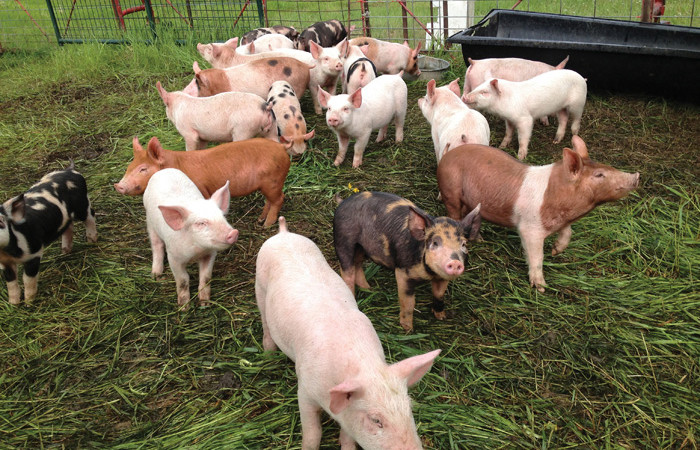

Pigs at pasture have poorer feed conversion efficiency than indoor pigs i.e. they consume more food to achieve the same liveweight gain. This is particularly true at lower temperatures where food is used to generate body heat so as to maintain normal body temperature. The energy required to do this will depend on how far below the animal’s critical temperature the external temperature is as well as the amount of body fat cover or body condition .
There are environmental risks associated with keeping pigs outdoors, and these are in part concerned with diffuse pollution caused by nutrient loss. Nitrogen losses occur in the form nitrate leaching, ammonia volatilization and denitrification contributing to eutrophication of natural environments, acid rain and global warming. Nutrient losses can also have impacts on subsequent crops if pigs are kept within a cropping rotation. Maintaining grass cover decreases the risk of nitrate leaching but this is difficult to achieve as pigs naturally root and, and in the process, destroy pasture.
Reducing dietary nitrogen, reducing stocking rate and keeping animals on susceptible pastures for only part of the year have all been identified as providing the most environmentally acceptable way of keeping pigs on pasture. Regular moving of huts, feeding and water troughs can be effective in ensuring that nutrients are more evenly distributed across paddocks.
In terms on behavior, Sows fed outdoors do not show high levels of aggression during feeding and low-ranking sows are not as disadvantaged to the same extent as seen indoors, and this is in part a result of having more space for retreat and avoidance.
However, in order to effectively manage pastured Pigs, below are some of the activities that can be implemented on your farm.
Extra feed will be needed in cold, wet weather.
Feeding should be carried out early and late during hot weather.
Feed should be spread out over an area large enough to avoid undue poaching of the feed face.
Good husbandry is required to avoid thin sows (condition scoring, grouping according to condition at weaning etc.) and fat sow syndrome (mastitis/metritis /agalactiae syndrome) and farrowing difficulties, particularly when pregnant sows are kept on new sites with plenty of grass (reduction of rations accordingly before farrowing).
Quick feeding methods should be used to avoid stress.
Adequate spreading of feed should be ensured to avoid aggression and stress (2 metrs per sow or more feed heaps than the number of sows in the group).
Reduce nutrient loss by feeding reduced nitrogen feeds, keep low stocking rates and regularly move housing, feed and water troughs.
 Contact Jaguza Support
Contact Jaguza Support